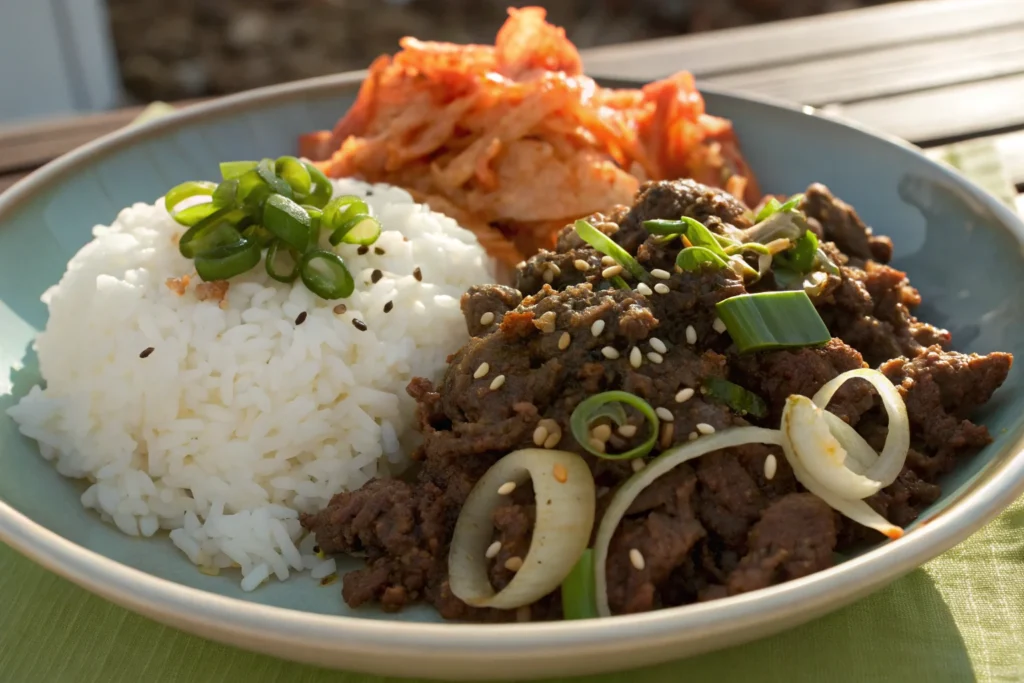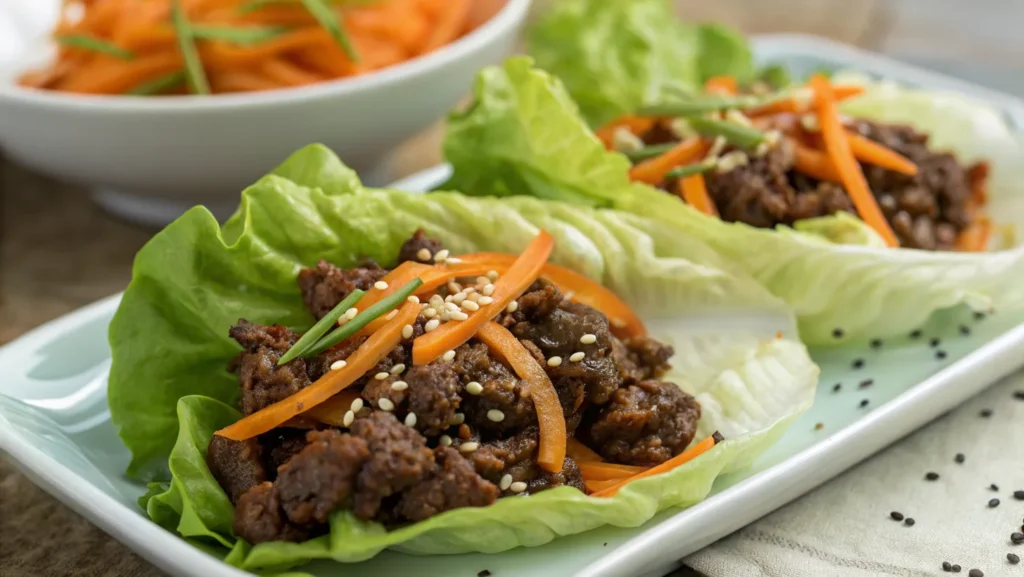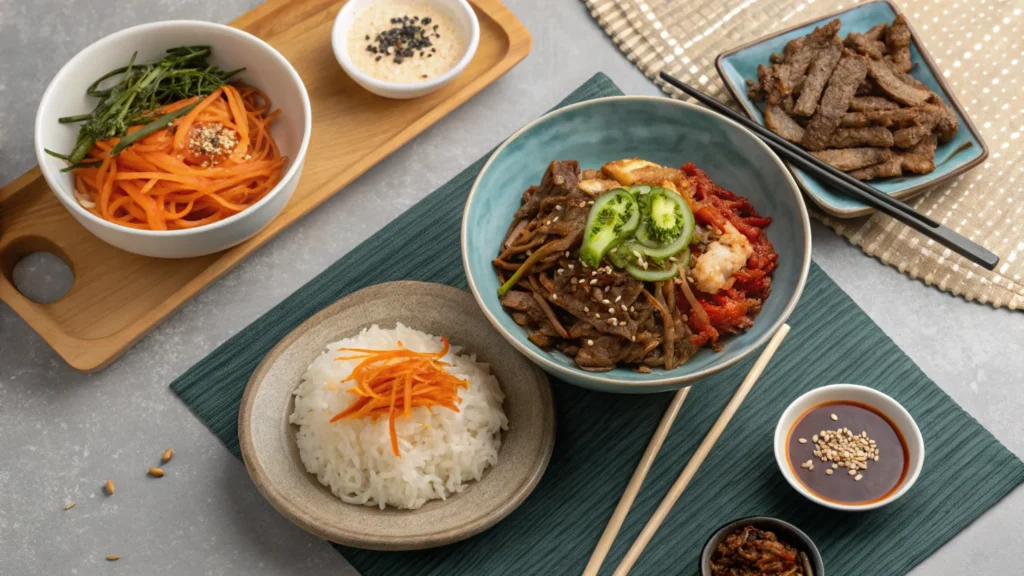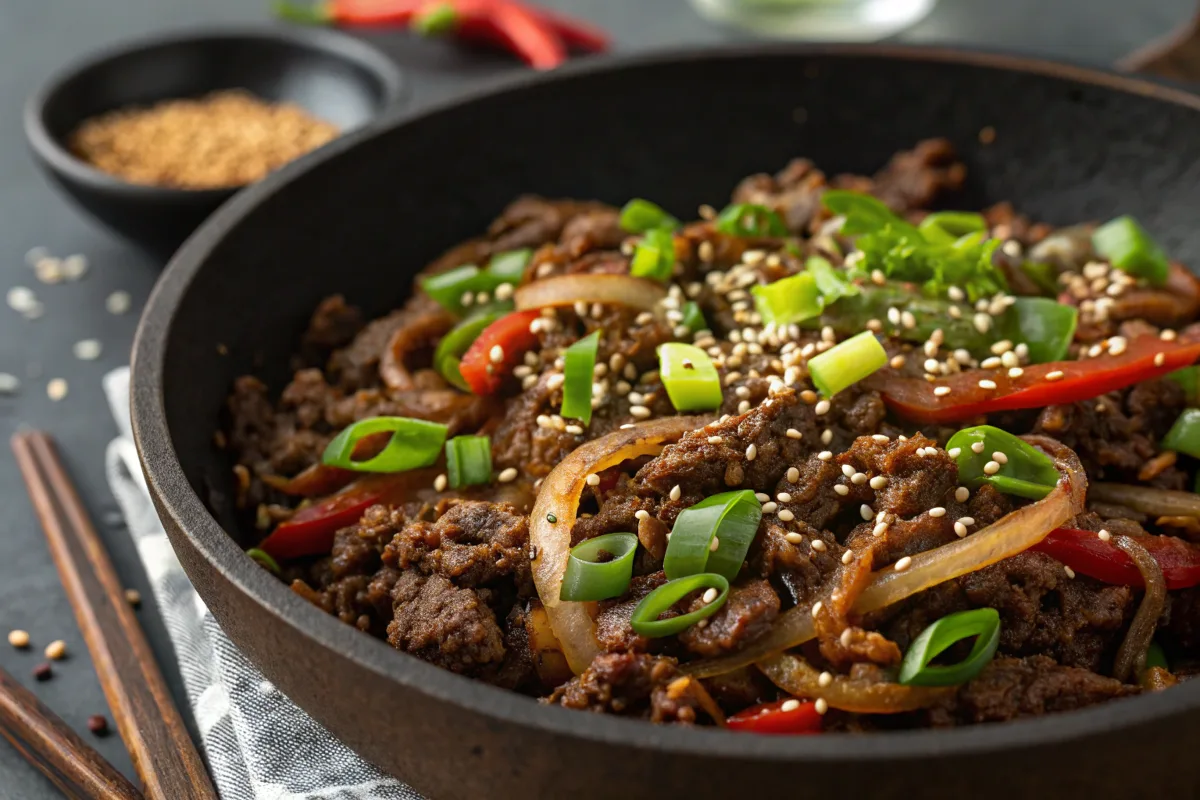Introduction
Korean cuisine is renowned for its vibrant flavors, and bulgogi is no exception. Traditionally made with thinly sliced beef, bulgogi has evolved to include a ground beef variation, making it more accessible and convenient without compromising its iconic taste. This dish combines the sweet and savory richness of soy sauce, sesame oil, and garlic with the versatility of ground beef, offering a perfect balance of flavor and practicality.
In this article, we’ll explore everything about ground beef bulgogi—its origin, how to prepare it, serving ideas, and tips for perfecting the dish. You’ll also learn about its health benefits, common mistakes to avoid, and creative ways to enjoy this Korean favorite. Whether you’re a seasoned cook or a beginner, this guide will make your bulgogi experience unforgettable.
Table of Contents
What is Ground Beef Bulgogi?
The Origin of Bulgogi
Bulgogi, which means “fire meat” in Korean, is one of Korea’s most popular and enduring dishes. Traditionally grilled or stir-fried, this marinated beef dish has been enjoyed for centuries as a luxurious treat. It is often made with thin slices of ribeye or sirloin, marinated in a savory-sweet mixture of soy sauce, sugar, sesame oil, garlic, and other ingredients.
The ground beef variation offers a modern twist, perfect for quick, everyday meals while retaining the essence of this classic dish. This adaptation is particularly popular among home cooks looking for a budget-friendly and time-efficient option.
For a deeper dive into traditional bulgogi and its variations, check out this authentic Bulgogi Korean Beef BBQ Recipe by Maangchi
Key Ingredients in Ground Beef Bulgogi
The magic of bulgogi lies in its marinade. For ground beef bulgogi, the marinade typically includes:
- Soy Sauce: The salty backbone of the dish.
- Brown Sugar or Honey: Adds sweetness to balance the savory flavors.
- Sesame Oil: Provides a nutty aroma.
- Garlic and Ginger: Bring depth and warmth.
- Green Onions: Add freshness and a mild, oniony kick.
Optional ingredients like red pepper flakes or gochujang (Korean chili paste) can be added for a spicy kick. The ground beef absorbs the marinade quickly, making it perfect for a fast meal.
Why Choose Ground Beef for Bulgogi?
Affordability and Accessibility
One of the biggest advantages of using ground beef for bulgogi is its cost-effectiveness. Traditional bulgogi uses premium cuts of beef like ribeye or sirloin, which can be expensive and harder to find. Ground beef, on the other hand, is widely available at most grocery stores and comes at a fraction of the cost. This makes it an excellent option for families or anyone cooking on a budget.
Additionally, ground beef doesn’t require special slicing or preparation, which is often necessary for traditional bulgogi. This simplicity makes it an accessible option for beginner cooks or those short on time.
Quick Cooking Time
Ground beef bulgogi is incredibly fast to prepare. Because the beef is already ground, it cooks evenly and quickly, typically within 5–7 minutes in a skillet. This is a significant time-saver compared to marinating and grilling thin slices of beef. Whether you’re making dinner after a long day or preparing meals for the week, ground beef bulgogi is a quick and satisfying solution.
Family-Friendly Meal
Ground beef bulgogi is a hit with all ages, making it an ideal choice for family dinners. Its mild, sweet, and savory flavors appeal to kids and adults alike. Plus, the texture of ground beef is easier for young children to enjoy compared to thin slices of grilled meat.
For families with dietary restrictions or picky eaters, ground beef bulgogi offers versatility. It can be served with various sides like steamed rice, noodles, or even wrapped in lettuce leaves for a low-carb option. You can also adjust the spice level to suit everyone’s preferences, making it as mild or as bold as you like.
Versatility in Dishes
Ground beef bulgogi isn’t just a standalone dish—it’s a gateway to creative meal ideas. Use it as a filling for tacos, a topping for rice bowls, or even as a savory addition to stir-fried noodles. Its adaptability means you can reinvent leftovers into something new and exciting.
How to Make Ground Beef Bulgogi (Step-by-Step Recipe)
Ingredients You’ll Need
To make authentic and flavorful ground beef bulgogi, gather these ingredients:
- Ground Beef (1 pound): Use lean or regular ground beef depending on your preference.
- Soy Sauce (3 tablespoons): Provides a salty, umami-rich base.
- Brown Sugar or Honey (2 tablespoons): Adds sweetness to balance the savory flavors.
- Sesame Oil (2 teaspoons): A must for its nutty aroma and taste.
- Garlic (4 cloves, minced): Essential for depth and aroma.
- Ginger (1 teaspoon, grated): For a fresh, spicy undertone.
- Green Onions (2 stalks, thinly sliced): Both for the marinade and as a garnish.
- Crushed Red Pepper Flakes or Gochujang (optional, 1 teaspoon): For a spicy kick.
- Vegetable Oil (1 tablespoon): For cooking the beef.
- Sesame Seeds (1 teaspoon): A finishing touch for nutty flavor and texture.
Step-by-Step Instructions
1. Prepare the Marinade
In a medium bowl, whisk together the soy sauce, brown sugar, sesame oil, minced garlic, grated ginger, and red pepper flakes or gochujang (if using). Stir until the sugar is dissolved, and the mixture is well combined.
2. Marinate the Ground Beef
Add the ground beef to the marinade and mix thoroughly. Ensure the marinade coats the meat evenly. Let it sit for at least 10 minutes. If you have extra time, marinate it for 30 minutes for enhanced flavor.
3. Cook the Ground Beef
Heat a large skillet or wok over medium-high heat. Add the vegetable oil and swirl to coat the pan. Add the marinated ground beef to the skillet, spreading it out into an even layer.
Cook the beef, breaking it into small crumbles with a spatula, until browned and fully cooked. This should take 5–7 minutes.
4. Reduce and Thicken the Sauce
Once the beef is cooked, allow the excess liquid in the pan to simmer for a couple of minutes. This step concentrates the flavors and gives the beef a rich, glossy coating.
5. Add Green Onions and Sesame Seeds
Stir in most of the sliced green onions and sprinkle with sesame seeds. Save a few for garnishing before serving.
Tips for Success
- Marination Time: Even a short marination enhances flavor, but for best results, marinate the beef for at least 30 minutes.
- Adjusting Sweetness: If you prefer a less sweet bulgogi, reduce the brown sugar slightly.
- Adding Vegetables: Toss in thinly sliced carrots, zucchini, or mushrooms during the cooking process for added nutrition and flavor.
Serving Suggestions
Serve your ground beef bulgogi over steamed rice or noodles, or use it as a filling for lettuce wraps or tacos. Garnish with more green onions and sesame seeds for a restaurant-quality finish.
Top Serving Suggestions for Ground Beef Bulgogi
Ground beef bulgogi is a versatile dish that pairs beautifully with a variety of sides and accompaniments. Whether you’re aiming for a traditional Korean meal or experimenting with fusion dishes, the options are endless. Here are some of the best ways to serve and enjoy this flavorful dish.
1. Classic Pairings: Rice and Noodles
- Steamed Rice: The most traditional way to enjoy ground beef bulgogi is over a bowl of steamed white or brown rice. The rice absorbs the flavorful juices, creating a perfect balance of textures and flavors.
- Fried Rice: Stir fry leftover ground beef bulgogi with day-old rice, an egg, and vegetables for a quick and delicious fried rice.
- Stir-Fried Noodles: Toss bulgogi with cooked udon or ramen noodles for a hearty, saucy meal.

2. Korean Side Dishes (Banchan)
Complete your meal by serving ground beef bulgogi with some of these popular Korean side dishes:
- Kimchi: The spicy, tangy crunch of fermented cabbage contrasts perfectly with the sweet and savory beef.
- Pickled Radish (Danmuji): A slightly sweet and refreshing side that cuts through the richness of the beef.
- Japchae: Korean glass noodles stir-fried with vegetables and sesame oil add a delightful texture.
- Seaweed Salad: Light and refreshing, it adds a unique briny flavor to the meal.
3. Fusion Ideas for Creative Meals
- Bulgogi Tacos: Stuff tortillas with ground beef bulgogi, shredded lettuce, and spicy gochujang mayo for a Korean-Mexican twist.
- Lettuce Wraps: Use crispy romaine or butter lettuce to make low-carb wraps. Add julienned carrots, cucumbers, and a drizzle of sesame oil for extra crunch and flavor.
- Bulgogi Bowls: Assemble a bulgogi bowl with rice, sautéed vegetables, a fried egg, and a sprinkle of sesame seeds.

Looking for another way to enjoy ground beef? Check out this recipe for The Best Baked Beans with Ground Beef—a smoky, hearty option to complement bulgogi
4. Crowd-Pleasing Appetizers
- Bulgogi Sliders: Use ground beef bulgogi as a topping for mini burger buns, garnished with slaw and spicy mayo.
- Spring Rolls: Roll bulgogi in rice paper with veggies and serve with a sesame dipping sauce.
From traditional rice pairings to inventive tacos and bowls, ground beef bulgogi is as versatile as it is flavorful. Experiment with these serving suggestions to create meals your family will love!
Tips for Perfecting Your Ground Beef Bulgogi
Creating the perfect ground beef bulgogi is easier than you think, but a few tips and tricks can elevate the flavors and texture to restaurant-quality. Here’s how you can take your bulgogi game to the next level.
1. Marination Secrets
- Marinate for the Right Amount of Time: While ground beef absorbs flavors quickly, allowing the meat to marinate for at least 30 minutes ensures deeper penetration of the sweet and savory flavors. If you’re short on time, even a 10-minute marinade will work.
- Don’t Overload the Sauce: Balance is key. Too much marinade can lead to a soggy texture, so ensure the beef is well-coated but not swimming in sauce.
2. Master the Cooking Techniques
- Use a Hot Pan: Heat your skillet or wok until it’s hot before adding the beef. A hot pan helps sear the meat, locking in juices and giving it a slightly caramelized flavor.
- Break Up the Meat: Use a wooden spoon or spatula to break the ground beef into small crumbles as it cooks. This ensures even cooking and allows more surface area to absorb the sauce.
- Cook in Batches (if needed): Overcrowding the pan can cause the beef to steam instead of brown. If you’re making a large batch, cook in smaller portions to achieve the best texture.
3. Adjusting Flavors
- Sweetness: Prefer a sweeter bulgogi? Add an extra teaspoon of brown sugar or honey.
- Spice: Mix in gochujang or crushed red pepper flakes for a spicy kick. Adjust the amount to your heat tolerance.
- Saltiness: Use low-sodium soy sauce if you want to control the salt level. You can always add a pinch of salt at the end if needed.
4. Adding Extra Ingredients
- Veggie Boost: Thinly sliced onions, julienned carrots, or chopped zucchini are great additions that enhance texture and flavor.
- Aromatics at the End: Stir in sliced green onions and sesame seeds in the last minute of cooking for a burst of freshness and nutty aroma.
5. Reheating and Storing
- Reheat Gently: Warm leftovers in a skillet over medium heat to maintain their texture and flavor. Avoid microwaving for too long, as it can dry out the meat.
- Store Properly: Ground beef bulgogi stays fresh in the refrigerator for up to three days. For longer storage, freeze it in an airtight container for up to three months.
Health Benefits of Ground Beef Bulgogi
Ground beef bulgogi is not only a flavorful dish but also a nutritious one when made with wholesome ingredients. Here’s a closer look at the health benefits it offers and how you can make it even healthier.
1. High-Quality Protein
Ground beef is an excellent source of protein, essential for building and repairing tissues in the body. A 3-ounce serving of ground beef provides around 22 grams of protein, which helps maintain muscle mass and supports overall health.
Pro Tip: Choose lean ground beef (90% lean or higher) to reduce saturated fat while still getting plenty of protein.
2. Packed with Nutrients
Ground beef contains vital nutrients like:
- Iron: Supports the production of red blood cells and helps prevent anemia.
- Zinc: Boosts the immune system and aids in wound healing.
- Vitamin B12: Essential for brain health and energy production.
The marinade, which typically includes garlic, ginger, and green onions, adds an extra layer of health benefits. Garlic and ginger are known for their anti-inflammatory and immune-boosting properties.
3. Balanced Meal Options
Ground beef bulgogi can easily be part of a balanced meal when paired with nutrient-rich sides:
- Vegetables: Add julienned carrots, mushrooms, or spinach to increase fiber and vitamins.
- Whole Grains: Serve with brown rice or quinoa for added complex carbohydrates and fiber.
4. Customizable for Dietary Needs
- Low-Sodium: Use low-sodium soy sauce to reduce salt intake.
- Low-Fat: Swap ground beef for ground turkey or plant-based alternatives.
- Low-Carb: Serve bulgogi in lettuce wraps or alongside a fresh salad.
For a plant-based twist on ground beef dishes, explore these Top 10 Ground Beef Chili Substitute Vegetarian Options to inspire your next meal
5. Energy Boosting
The mix of protein and carbohydrates (when served with rice or noodles) makes ground beef bulgogi an excellent meal for sustained energy. It’s perfect for lunch or dinner, fueling you for an active lifestyle.
Common Mistakes to Avoid When Making Bulgogi
Ground beef bulgogi is an easy dish to prepare, but small missteps can impact its flavor and texture. Here are the most common mistakes and how to avoid them to ensure perfect results every time.
1. Skipping the Marinade
The marinade is the heart of bulgogi. Skipping this step results in bland meat. Even a quick 10-minute marinade can infuse the beef with essential flavors like soy sauce, garlic, and sesame oil.
Solution: Plan ahead and marinate for at least 30 minutes whenever possible.
2. Overcooking the Beef
Ground beef cooks quickly, and overcooking it can make the meat dry and crumbly, reducing its juiciness.
Solution: Cook the beef over medium-high heat and watch closely. Stir frequently to cook it evenly without drying it out.
3. Using the Wrong Pan
A small or crowded pan causes the beef to steam instead of brown, leading to a less flavorful dish.
Solution: Use a large skillet or wok with enough surface area to cook the meat in a single layer. Cook in batches if needed.
4. Neglecting the Balance of Flavors
Too much soy sauce can make the dish overly salty, while excessive sugar may overpower the savory notes.
Solution: Stick to the recommended marinade proportions and adjust to taste gradually.
5. Forgetting the Garnish
Green onions and sesame seeds are more than decoration—they add freshness and a nutty crunch that complements the rich beef.
Solution: Always finish your dish with garnishes for a professional touch.
Related Korean Recipes to Try
Ground beef bulgogi is just the beginning of your journey into Korean cuisine. Whether you want to complement your meal or explore other iconic dishes, these recipes are flavorful, versatile, and perfect for broadening your culinary horizons.

For a cozy, hearty meal alongside bulgogi, consider making Chicken Pot Pie with Biscuits—a classic comfort food recipe.
1. Bibimbap
What It Is: Bibimbap is a vibrant Korean rice bowl topped with sautéed vegetables, bulgogi (or other proteins), a fried egg, and a dollop of spicy gochujang.
Why It Pairs Well: Ground beef bulgogi can serve as the protein base for this dish, making it a hearty, one-bowl meal. The variety of textures and flavors in bibimbap is sure to impress your taste buds.
2. Japchae
What It Is: Japchae is a stir-fried noodle dish made with sweet potato glass noodles, vegetables, and a savory-sweet sauce.
Why It Pairs Well: The mild flavors of japchae balance beautifully with the bold, rich taste of bulgogi. Serve them side by side for a complete meal.
3. Kimchi Fried Rice
What It Is: A quick and easy stir-fried rice dish featuring kimchi, a Korean staple made of fermented cabbage.
Why It Pairs Well: Adding ground beef bulgogi to this dish creates a perfect combination of savory, spicy, and tangy flavors. It’s also an excellent way to use leftovers.
4. Korean Pancakes (Pajeon)
What It Is: Pajeon are crispy, savory pancakes made with scallions and often paired with seafood or vegetables.
Why It Pairs Well: Serve pajeon alongside bulgogi for an appetizer or snack that complements the main dish’s rich flavors.
5. Tteokbokki
What It Is: Tteokbokki features chewy rice cakes cooked in a spicy-sweet red chili sauce.
Why It Pairs Well: This dish’s bold spice contrasts beautifully with the slightly sweet and savory bulgogi, creating a balanced meal.
Conclusion and Final Thoughts
Ground beef bulgogi is more than just a quick and budget-friendly version of a classic Korean dish—it’s a gateway to bold flavors and endless culinary possibilities. Its sweet, savory, and slightly nutty profile makes it a crowd-pleaser, whether served over rice, wrapped in lettuce, or reimagined in fusion dishes like tacos or sliders.
This dish showcases the beauty of Korean cuisine, offering a balance of simplicity and sophistication. By marinating ground beef with staples like soy sauce, sesame oil, garlic, and ginger, you can create a meal that’s both easy to prepare and full of rich, authentic flavors. With the tips and tricks shared here, along with creative serving ideas, you’re set to elevate your cooking game.
Incorporating ground beef bulgogi into your meal rotation not only introduces global flavors to your kitchen but also provides a nutritious and satisfying option for family dinners, meal prep, or special occasions. Its adaptability means you can experiment with various ingredients, spice levels, and serving styles, making it a dish that never gets old.
So, gather your ingredients and give this recipe a try. Whether you’re a seasoned fan of Korean food or a curious newcomer, ground beef bulgogi is sure to impress your taste buds and those of anyone you share it with.
FAQs About Ground Beef Bulgogi
If you’re new to making ground beef bulgogi or want to fine-tune your technique, these frequently asked questions will help. Let’s clear up some common doubts about this delicious dish.
1. What’s the difference between traditional bulgogi and ground beef bulgogi?
Traditional bulgogi uses thinly sliced cuts of beef, like ribeye or sirloin, which are grilled or pan-fried. Ground beef bulgogi, on the other hand, uses minced beef for a quicker and more budget-friendly version. Both share the same bold marinade flavors, but ground beef bulgogi has a slightly different texture and is often easier to prepare.
2. Can I freeze leftovers?
Yes, ground beef bulgogi freezes well! Store leftovers in an airtight container or freezer-safe bag for up to three months. When reheating, thaw it overnight in the refrigerator and warm in a skillet over medium heat to preserve its texture and flavor.
3. What type of beef works best for bulgogi?
For ground beef bulgogi, use lean ground beef (90% lean or higher) for a healthier option, or regular ground beef if you prefer a richer flavor. The fat in the beef helps absorb the marinade, so avoid extra-lean options unless you’re adding a bit of oil.
4. How do I make bulgogi spicy?
To add a spicy kick, include ingredients like:
- Gochujang (Korean chili paste): Start with 1 teaspoon and adjust to taste.
- Crushed red pepper flakes: Sprinkle into the marinade or directly into the skillet while cooking.
Spice levels can be tailored to your preference without altering the dish’s core flavors.
5. Can I make bulgogi with plant-based ground beef?
Absolutely! Many plant-based ground beef alternatives work well with bulgogi marinades. Opt for soy-based or pea protein crumbles that mimic the texture of ground beef. Be mindful of the cooking time, as plant-based meat often cooks faster.
6. What are some alternative marinades for bulgogi?
While the classic marinade includes soy sauce, sesame oil, garlic, and sugar, you can experiment with variations like:
- Teriyaki Sauce: For a sweeter, Japanese-inspired flavor.
- Coconut Aminos: A soy-free alternative with a slightly sweeter profile.
- Hoisin Sauce: Adds depth and a hint of smokiness.

